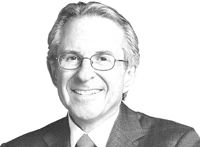Leadership: Pareto's Principle
Pharmaceutical Executive
It's a funny law of nature: 20 percent of the clouds produce 80 percent of the rain. And 20 percent of the people do 80 percent of the work. OK, leader, what do you plan to do about it?
Back in 1906, economist Vilfredo Pareto noted a striking fact in his native Italy: Twenty percent of the people owned 80 percent of the wealth. As Pareto looked about, he discovered that the "80/20 Principle," as it came to be known, applied in many realms of life. He was particularly fascinated to find that 20 percent of the peapods in his garden yielded 80 percent of his harvest!

Sander A. Flaum
Over time, the 80/20 formula has been found to apply to criminals and the number of crimes committed; to accident-prone motorists and the number of car accidents; even to the most-trodden parts of carpets as a proportion of total wear and tear. Less than 20 percent of the world's land yields more than 80 percent of all food; fewer than 20 percent of clouds produce 80 percent of rain; in business services, 20 percent of clients typically account for 80 percent of profits.
In the 1930s, a pioneering quality-management specialist named Joseph Juran extended the 80/20 Principle to what he termed the "vital few and trivial many." Among hordes of middle and senior managers on organizational charts, most are "trivial." The wise business leader knows how to find the "vital few" who have an impact on performance.
Juran's observation was reconfirmed in a recent study of 25,000 salespeople in 160 industries, which concluded that 55 percent of them were ill-suited to salesmanship; half of the remainder sold "the wrong thing in the wrong place." Conclusion: 20 percent produced 80 percent of the sales.
That study wound down at the end of the Jack Welch era at General Electric. During his more than 20 years of dynamic leadership, GE increased in value more than 30 times to become the world's richest corporation—and the world's second biggest in market value.
Welch had his own version of 80/20, designed to weed out the trivial many and focus on the vital few. He broke staffing down to a "vitality curve" of three segments. The top tier (20 percent) performed best and earned the biggest bonuses. The B list (60 percent) included managers with a potential to rise to the top. Those destined to sink to the bottom were ultimately dismissed (20 percent).
Welch was blunt and courageous, unconcerned about being popular. Results mattered most. Here's what he said about downsizing: "Strong managers who make tough decisions to cut jobs provide the only true job security in today's world. Weak managers are the problem. Weak managers destroy jobs."
Welch also developed a "4 E's" formulation of business leadership. "Energy" people, he noted, move at 95 miles per hour in a 55 MPH world. "Energizers" provide the spark that gets others excited about the task at hand. "Edge" designates competitive types who know how to hire, fire, and promote—and who regard roadblocks as challenges, not impediments. "Execution" refers to people who get things done, who channel their work directly to the bottom line.
Welch's focus on excellence led to the record number of leaders who would leave GE to run other companies, accounting by far for more Fortune 500 CEOs who came from one company than from any other.
Richard Koch, in his remarkable book, Living the 80/20 Way, describes the 80/20 Principle as "one of the most mind-blowing, far-reaching and surprising discoveries of the past 200 years."
"If you took 100 people and divided them into a team of 80 and a team of 20," he wrote, "you'd expect the team of 80 to achieve four times as much. However, if you put the 20 top people in one group and the 80 other people in another group, something much different happens. The 20 people not only achieve more than the 80 people, but they achieve four times more than the larger group."
How to apply 80/20 to your business? Koch recommends focusing on one or two points that matter most and "find your 80/20 route....Work out three 80/20 actions to get you started. Each one must take you a giant leap along your 80/20 route toward your 80/20 destination."
More specific paths to "80/20," of course, depend on the many variables within an organization. Who are my best thinkers? Whom should I turn to at crunch time? Can I leapfrog the organizational chart and maintain stability?
Finally, do I want to be a Jack Welch-type leader in order to earn Jack Welch-type results? Frankly, it can't be done without adapting at least some of his managerial style.
Sander A. Flaum is managing partner of Flaum Partners. He can be reached at sflaum@flaumpartners.com

The Misinformation Maze: Navigating Public Health in the Digital Age
March 11th 2025Jennifer Butler, chief commercial officer of Pleio, discusses misinformation's threat to public health, where patients are turning for trustworthy health information, the industry's pivot to peer-to-patient strategies to educate patients, and more.
Applying Porter’s Five Forces to Portfolio Management in Pharmaceutical R&D: A Strategic Roadmap
March 17th 2025The increasing costs and complexity of R&D in the pharmaceutical industry have necessitated the adoption of strategic portfolio management to optimize resource allocation and enhance competitive advantage.
Navigating Distrust: Pharma in the Age of Social Media
February 18th 2025Ian Baer, Founder and CEO of Sooth, discusses how the growing distrust in social media will impact industry marketing strategies and the relationships between pharmaceutical companies and the patients they aim to serve. He also explains dark social, how to combat misinformation, closing the trust gap, and more.